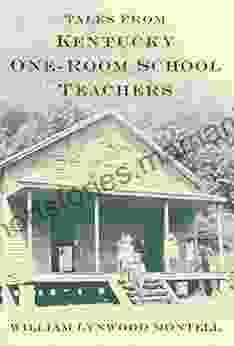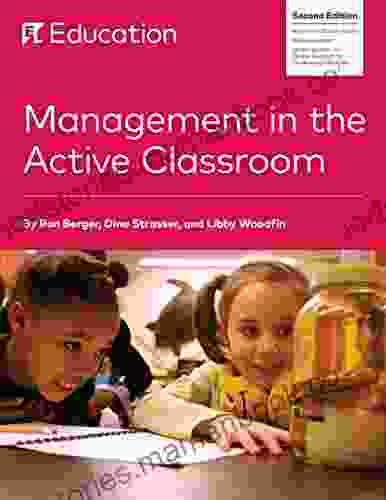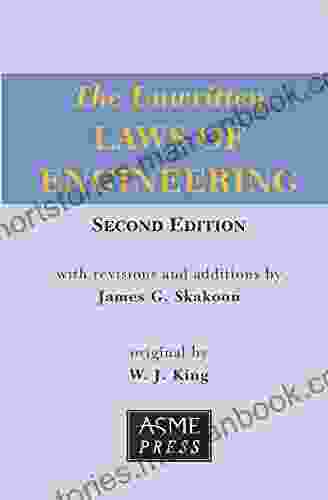Management in the Active Classroom: A Comprehensive Guide for Educators

4.7 out of 5
| Language | : | English |
| File size | : | 9573 KB |
| Text-to-Speech | : | Enabled |
| Screen Reader | : | Supported |
| Enhanced typesetting | : | Enabled |
| Word Wise | : | Enabled |
| Print length | : | 187 pages |
In the transformative landscape of modern education, active classrooms emerge as spaces where students engage in hands-on learning, collaborate effectively, and embrace their role as active participants in the construction of knowledge. However, fostering such vibrant learning environments necessitates a robust management framework that supports student agency, promotes inclusivity, and cultivates a positive classroom culture.
This comprehensive guide will illuminate the essential principles and strategies of management in active classrooms, empowering educators to create dynamic and empowering learning experiences for all students. We shall delve into the core elements of classroom management, exploring effective techniques for establishing routines, setting clear expectations, fostering productive interactions, and addressing challenging behaviors.
Core Principles of Classroom Management
1. Positive Relationships:
Building strong relationships with students is the cornerstone of effective management. By demonstrating empathy, respect, and warmth, educators can foster a climate of trust and support, where students feel safe and valued. This positive rapport lays the foundation for open communication, collaboration, and a shared sense of purpose.
2. Clear Expectations:
Establishing clear expectations from the outset is crucial for creating a structured and predictable learning environment. Educators should collaboratively develop classroom rules and procedures with students, ensuring they are understood, respected, and consistently enforced. Transparent expectations empower students to take ownership of their behavior and promote accountability.
3. Consistent Consequences:
Fair and consistent consequences for both positive and negative behaviors are essential for maintaining classroom order and fostering a sense of justice. Consequences should be clearly defined, proportional to the behavior, and administered in a respectful and supportive manner. By consistently applying consequences, educators reinforce appropriate behaviors and discourage inappropriate ones.
4. Proactive Interventions:
Effective management involves proactive strategies that prevent challenging behaviors before they occur. Educators can utilize techniques such as setting clear expectations, establishing routines, and providing positive reinforcement to create a positive and supportive classroom culture. By identifying potential triggers and addressing them preemptively, educators can minimize disruptions and maintain a conducive learning environment.
5. Differentiated Approaches:
Recognizing the diverse needs and learning styles of students, educators should adopt differentiated management strategies. By tailoring interventions to individual students' challenges, they can provide targeted support and address specific behavioral issues effectively. This personalized approach ensures that all students receive the support they need to succeed.
Strategies for Active Classrooms
1. Establish Flexible Grouping:
Active classrooms thrive on collaboration and peer interaction. Educators should create flexible grouping strategies, allowing students to work in pairs, small groups, or as a whole class, depending on the learning activity. This variety fosters diverse perspectives, promotes social skills, and caters to different learning styles.
2. Incorporate Movement and Play:
Movement and play are essential components of active learning. Educators can integrate movement-based activities, such as brain breaks, kinesthetic games, and hands-on experiments, into their lessons. These activities enhance engagement, reduce restlessness, and improve cognitive function.
3. Utilize Technology for Collaboration:
Technology can be a powerful tool for collaboration and engagement in active classrooms. Educators can use interactive whiteboards, online platforms, and collaborative apps to facilitate group work, share resources, and provide students with opportunities to engage with theirpeers beyond the physical classroom.
4. Implement Student-Led Discussions:
Empowering students to lead discussions encourages active participation and critical thinking. Educators can assign students specific roles, such as discussion leaders, timekeepers, or note-takers, to foster ownership and engagement. This strategy promotes student voice, develops leadership skills, and enhances understanding.
5. Provide Regular Feedback:
Ongoing feedback is essential for student growth and motivation. Educators should provide regular and specific feedback to students, both formally and informally. This feedback should be timely, constructive, and focused on supporting student learning. By providing feedback, educators help students identify areas for improvement and celebrate their successes.
Cultivating an Inclusive Classroom
1. Embrace Diversity:
Active classrooms should be inclusive spaces that value and celebrate diversity. Educators should make a conscious effort to create a welcoming environment for all students, regardless of their cultural background, learning style, or abilities. This involves adapting teaching methods, providing differentiated support, and fostering a culture of respect and acceptance.
2. Establish a Respectful Community:
A strong sense of community is essential for inclusivity. Educators should work with students to establish a respectful community where everyone's voice is valued. This involves setting clear expectations for respectful behavior, modeling empathy and kindness, and addressing any instances of discrimination or prejudice.
3. Provide Universal Access to Learning:
All students should have equal access to learning opportunities. Educators should identify and remove barriers to learning for students with disabilities or special needs. This may involve providing assistive technology, modifying assignments, or offering individualized support. By ensuring universal access, educators create a truly inclusive learning environment.
Addressing Challenging Behaviors
1. Understand the Root Causes:
To effectively address challenging behaviors, educators need to understand the underlying causes. This may involve observing the student's behavior, talking to them directly, or consulting with parents or school counselors. Identifying the root causes helps educators develop targeted interventions that address the specific needs of the student.
2. Implement Positive Behavioral Supports:
Positive behavioral supports are strategies designed to reinforce appropriate behaviors and reduce challenging ones. These supports may include providing positive reinforcement, setting clear expectations, and teaching students alternative behaviors. By focusing on positive behaviors, educators can create a supportive and encouraging learning environment.
3. Collaborate with Families and Support Staff:
Collaborating with families and support staff is essential for addressing challenging behaviors effectively. Educators should keep families informed about their child's behavior and work together to develop a comprehensive plan. Support staff, such as school counselors or social workers, can provide additional insights and support.
Management in the active classroom is a complex and multifaceted endeavor that requires educators to embrace a proactive, positive, and inclusive approach. By implementing the strategies outlined in this guide, educators can create a dynamic learning environment where students are engaged, empowered, and successful. Remember, effective management is not merely about controlling behavior but about fostering a culture of respect, collaboration, and lifelong learning.
As educators, we have the privilege of shaping the minds of the future. By embracing the principles and practices of effective management in active classrooms, we can empower our students to become confident, capable, and compassionate learners who are ready to make a positive impact on the world.
4.7 out of 5
| Language | : | English |
| File size | : | 9573 KB |
| Text-to-Speech | : | Enabled |
| Screen Reader | : | Supported |
| Enhanced typesetting | : | Enabled |
| Word Wise | : | Enabled |
| Print length | : | 187 pages |
Do you want to contribute by writing guest posts on this blog?
Please contact us and send us a resume of previous articles that you have written.
 Top Book
Top Book Novel
Novel Fiction
Fiction Nonfiction
Nonfiction Literature
Literature Paperback
Paperback Hardcover
Hardcover E-book
E-book Audiobook
Audiobook Bestseller
Bestseller Classic
Classic Mystery
Mystery Thriller
Thriller Romance
Romance Fantasy
Fantasy Science Fiction
Science Fiction Biography
Biography Memoir
Memoir Autobiography
Autobiography Poetry
Poetry Drama
Drama Historical Fiction
Historical Fiction Self-help
Self-help Young Adult
Young Adult Childrens Books
Childrens Books Graphic Novel
Graphic Novel Anthology
Anthology Series
Series Encyclopedia
Encyclopedia Reference
Reference Guidebook
Guidebook Textbook
Textbook Workbook
Workbook Journal
Journal Diary
Diary Manuscript
Manuscript Folio
Folio Pulp Fiction
Pulp Fiction Short Stories
Short Stories Fairy Tales
Fairy Tales Fables
Fables Mythology
Mythology Philosophy
Philosophy Religion
Religion Spirituality
Spirituality Essays
Essays Critique
Critique Commentary
Commentary Glossary
Glossary Bibliography
Bibliography Index
Index Table of Contents
Table of Contents Preface
Preface Introduction
Introduction Foreword
Foreword Afterword
Afterword Appendices
Appendices Annotations
Annotations Footnotes
Footnotes Epilogue
Epilogue Prologue
Prologue J Hopkin
J Hopkin Gil Baumgarten
Gil Baumgarten Jennifer Sweeney
Jennifer Sweeney Kim Vi Nguyen
Kim Vi Nguyen Andy Ankowski
Andy Ankowski Thomas Henry Huxley
Thomas Henry Huxley Jeff Kinney
Jeff Kinney Kara Grand
Kara Grand Jeff Wheeler
Jeff Wheeler Julie Von
Julie Von Mark Arax
Mark Arax David Sheff
David Sheff J Rishi Dadhichi
J Rishi Dadhichi Alphonso W Knight Sr
Alphonso W Knight Sr Nancy Devries Guth
Nancy Devries Guth Stephanie Chan
Stephanie Chan Jp Lovoclock
Jp Lovoclock Edward W Said
Edward W Said Heng Ou
Heng Ou Joe Bronski
Joe Bronski
Light bulbAdvertise smarter! Our strategic ad space ensures maximum exposure. Reserve your spot today!

 Charlie ScottUnveiling the Tapestry of Kentucky's One-Room Schoolhouse Legacy: Stories...
Charlie ScottUnveiling the Tapestry of Kentucky's One-Room Schoolhouse Legacy: Stories...
 Julio Ramón RibeyroThe Ultimate Options Trading Crash Course: Discover The Most Powerful...
Julio Ramón RibeyroThe Ultimate Options Trading Crash Course: Discover The Most Powerful...
 Herb SimmonsThe Texas Victory That Changed American History: The Battle of San Jacinto...
Herb SimmonsThe Texas Victory That Changed American History: The Battle of San Jacinto...
 Asher BellUnveiling the Enigmatic Allure of Dark Mafia Romance: A Captivating Dive into...
Asher BellUnveiling the Enigmatic Allure of Dark Mafia Romance: A Captivating Dive into... Dean ButlerFollow ·15.5k
Dean ButlerFollow ·15.5k Heath PowellFollow ·19.8k
Heath PowellFollow ·19.8k Blake KennedyFollow ·12.8k
Blake KennedyFollow ·12.8k Cormac McCarthyFollow ·5.7k
Cormac McCarthyFollow ·5.7k Ivan TurgenevFollow ·10.4k
Ivan TurgenevFollow ·10.4k Reginald CoxFollow ·15.3k
Reginald CoxFollow ·15.3k Arthur Conan DoyleFollow ·19k
Arthur Conan DoyleFollow ·19k Jamie BellFollow ·19.6k
Jamie BellFollow ·19.6k

 Bob Cooper
Bob CooperThe Fading Flower and Swallowing the Sun: Unveiling the...
"The Fading Flower and...

 Jesus Mitchell
Jesus MitchellLa Danza by Rossini: A Captivating Work for Flute Quartet
La Danza is a captivating composition for...

 Ivan Turgenev
Ivan TurgenevThe Never King: Vicious Lost Boys - A Dark and Twisted...
In the realm of Neverland, where shadows dance...

 Herb Simmons
Herb SimmonsThe Stone of Inheritance: Unraveling the Mysteries of a...
A Legacy of Enigmas In the annals of history,...
4.7 out of 5
| Language | : | English |
| File size | : | 9573 KB |
| Text-to-Speech | : | Enabled |
| Screen Reader | : | Supported |
| Enhanced typesetting | : | Enabled |
| Word Wise | : | Enabled |
| Print length | : | 187 pages |








